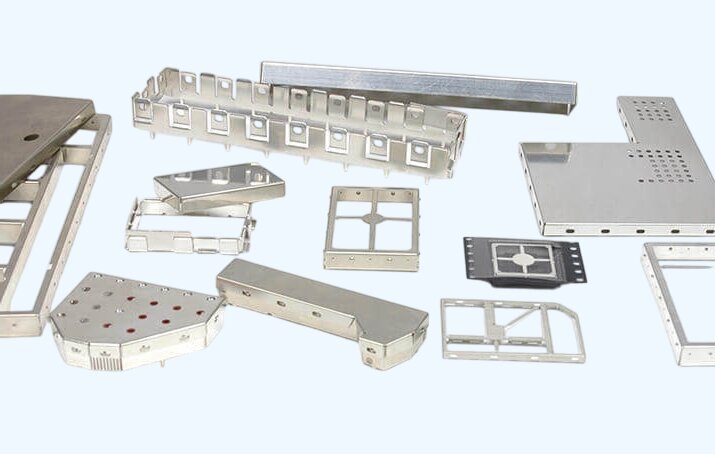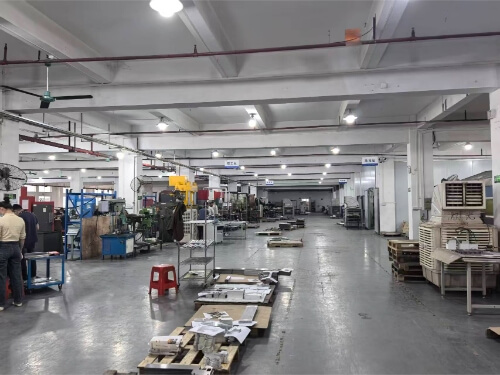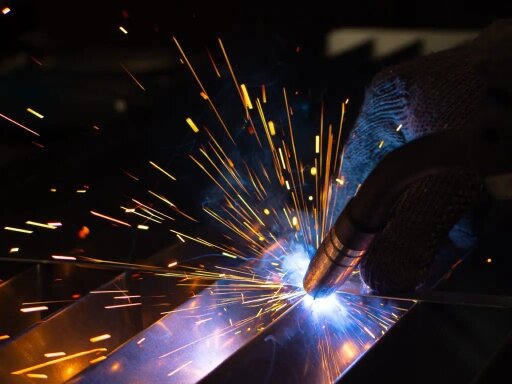Die Schweißmontage ist ein wichtiger Prozess in der Fertigung, der Präzision und Geschicklichkeit erfordert. Dabei werden Teile durch Hitze, Druck oder beides miteinander verbunden. Die Beherrschung der Schweißmontage kann jedoch eine Herausforderung sein. Die richtigen Techniken und Methoden sind entscheidend, um starke, dauerhafte Verbindungen zu gewährleisten.
Die Schweißmontage ist für Branchen wie die Automobilindustrie, die Luft- und Raumfahrt und das Bauwesen von entscheidender Bedeutung. Wenn Sie die besten Verfahren befolgen, können Sie die Festigkeit und Qualität Ihrer Schweißnähte verbessern. Sehen wir uns die Techniken genauer an.
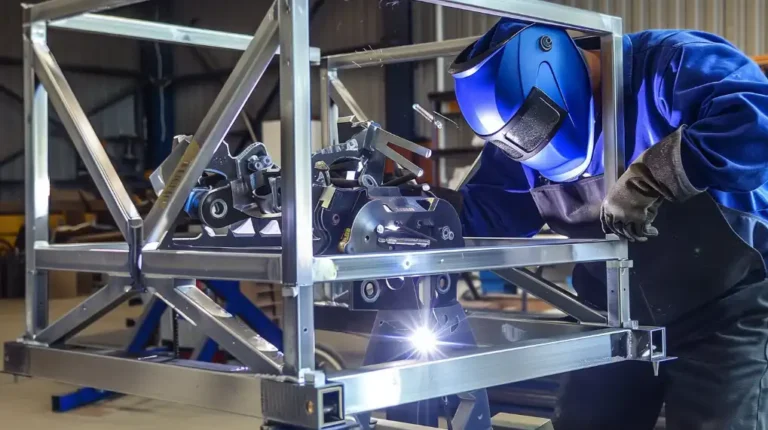
Was ist Schweißmontage?
Das Schweißen ist eine Methode, um zwei oder mehr Metallteile zu verbinden. Dies geschieht durch Anwendung von Hitze, Druck oder beidem zusammen mit einem Zusatzwerkstoff. Das Hauptziel besteht darin, eine starke, dauerhafte Verbindung herzustellen, die Belastungen und Umwelteinflüssen standhält.
Es gibt verschiedene Techniken, wie MIG-Schweißen, WIG-Schweißen und Stick-Schweißen. Jede Methode hat ihre Stärken, je nach Material und Anwendung.
Standard-Schweißtechniken in der Montage
Das Schweißen kann mit verschiedenen Techniken erfolgen, die alle ihre Vorteile haben. Jede Methode eignet sich für unterschiedliche Anwendungen, je nach den Anforderungen des Projekts.
MIG-Schweißen
MIG-Schweißen ist eine beliebte Herstellungsmethode. Es ist dafür bekannt, dass es schnell und einfach zu handhaben ist. Bei dieser Technik werden eine kontinuierliche Drahtelektrode und Schutzgas verwendet, um eine starke Verbindung herzustellen. Das MIG-Schweißen eignet sich hervorragend für die Großserienproduktion und ist für viele Metalle wie Stahl und Aluminium geeignet.
WIG-Schweißen
WIG-Schweißen ist bekannt für saubere, präzise Schweißnähte. Beim MIG-Schweißen wird eine Wolframelektrode zur Wärmeerzeugung und ein Schweißdraht zum Verbinden der Materialien verwendet. Diese Methode ist langsamer als das MIG-Schweißen, liefert aber qualitativ hochwertigere Ergebnisse. Es ist ideal für detaillierte Projekte oder Materialien wie Edelstahl und Titan.
Stabschweißen
Stabschweißenauch bekannt als SMAW (Shielded Metal Arc Welding), ist eine der flexibelsten Methoden. Dabei wird eine abschmelzende Elektrode verwendet, die mit einem Flussmittel beschichtet ist, das Hitze erzeugt und ein Schweißbad bildet. Das Stangenschweißen wird häufig im Freien eingesetzt und eignet sich hervorragend zum Schweißen dicker Materialien.

Faktoren, die die Auswahl des Schweißverfahrens beeinflussen
Das richtige Schweißverfahren hängt von mehreren Faktoren ab. Diese Faktoren gewährleisten eine starke, zuverlässige und kostengünstige Schweißnaht.
Wesentliche Überlegungen
Das Material, das Sie schweißen, beeinflusst das von Ihnen gewählte Verfahren. Verschiedene Metalle erfordern unterschiedliche Schweißverfahren. Aluminium zum Beispiel erfordert WIG-Schweißen für eine saubere, präzise Schweißnaht. Stahl ist flexibler. Je nach Dicke und benötigter Festigkeit kann er mit MIG- oder Stick-Schweißen geschweißt werden.
Verbindungsdesign und Schweißposition
Die Art der Verbindung beeinflusst das Schweißverfahren. Zum Beispiel können T-Verbindungen oder Stumpfnähte spezielle Techniken erfordern, um eine starke Verbindung herzustellen. Auch die Schweißposition spielt eine Rolle. Das Schweißen in flacher, horizontaler, vertikaler oder Überkopf-Position kann beeinflussen, wie einfach oder schwierig die Arbeit ist.
Anforderungen an die Geschwindigkeit
In Umgebungen mit hohen Stückzahlen sind in der Regel schnelle Schweißtechniken erforderlich. MIG- oder Punktschweißen werden bevorzugt, weil sie schnell und effizient sind. Für präzise Arbeiten in kleinen Stückzahlen kann das WIG-Schweißen besser geeignet sein, auch wenn es langsamer ist.
Materialien für geschweißte Baugruppen
Die in geschweißten Bauteilen verwendeten Materialien haben einen erheblichen Einfluss auf den Schweißprozess, die gewählten Techniken und die Festigkeit des Endprodukts. Im Folgenden werden einige gängige Werkstoffe für geschweißte Baugruppen vorgestellt:
Stahl
Stahl ist einer der am häufigsten verwendeten Schweißwerkstoffe. Er ist stabil, vielseitig und leicht zu schweißen. Es gibt verschiedene Arten von Stahl, darunter Kohlenstoffstahl, rostfreier Stahl und legierter Stahl. Jede Art hat ihre eigenen Schweißanforderungen.
Aluminium
Aluminium ist leicht und korrosionsbeständig, was es zu einer beliebten Wahl für Branchen wie die Luft- und Raumfahrt und die Automobilindustrie macht. Aufgrund seines niedrigeren Schmelzpunkts und seiner Neigung, Feuchtigkeit zu absorbieren, ist es jedoch schwieriger zu schweißen als Stahl.
Rostfreier Stahl
Rostfreier Stahl ist für seine Korrosionsbeständigkeit und Langlebigkeit bekannt. Er erfordert präzises Schweißen, um sein Aussehen und seine korrosionsbeständigen Eigenschaften zu erhalten. WIG- und MIG-Schweißen sind die gängigsten Verfahren für nichtrostenden Stahl.
Kupfer und Kupferlegierungen
Kupfer und seine Legierungen zeichnen sich durch eine hervorragende Leitfähigkeit und Korrosionsbeständigkeit aus. Das Schweißen von Kupfer erfordert eine sorgfältige Temperaturkontrolle, da es leicht überhitzen und spröde werden kann. MIG- und WIG-Schweißen werden in der Regel für Kupferlegierungen verwendet, obwohl für bestimmte Legierungen spezielle Techniken erforderlich sein können.

Vorbereitung zum Schweißen
Die richtige Vorbereitung ist entscheidend für qualitativ hochwertige Schweißnähte. Hier sind die wichtigsten Bereiche, auf die Sie sich in der Vorbereitungsphase konzentrieren sollten:
Materialvorbereitung und Reinigung
Vor dem Schweißen müssen die Materialien sauber und frei von Verunreinigungen sein. Rost, Öl, Schmutz oder Farbe können die Schweißnaht schwächen und Fehler verursachen. Durch die Reinigung wird sichergestellt, dass sich das Schweißbad richtig bildet und die Schweißnaht verstärkt wird.
Fugenvorbereitung und -anpassung
Die Kanten der Materialien müssen angemessen vorbereitet werden, um eine starke Verbindung zu gewährleisten. Dazu kann das Abschrägen, Anfasen oder Schleifen der Kanten gehören, damit sie perfekt zusammenpassen. Auch die Passung der Verbindung ist wichtig. Die Teile müssen richtig ausgerichtet sein, ohne Lücken oder Ausrichtungsfehler, die zu einer schlechten Schweißqualität führen könnten.
Prüfung und Inspektion vor dem Schweißen
Durch Prüfungen und Inspektionen vor dem Schweißen wird sichergestellt, dass alles in Ordnung ist, bevor der Schweißprozess beginnt. Dazu gehören die Überprüfung der Materialspezifikationen, um die Kompatibilität zu gewährleisten, die Bestätigung des Verbindungsdesigns und die Überprüfung der Passgenauigkeit.
Vorteile der schweißtechnischen Montage
Die Schweißmontage ist aufgrund ihrer vielen Vorteile eine beliebte Methode in der Fertigung. Sie ist kostengünstig, effizient und zuverlässig bei der Verbindung von Materialien. Hier sind einige der wichtigsten Vorteile der Schweißmontage:
Kosten-Wirksamkeit
Schweißen ist oft billiger als andere Verbindungsmethoden, wie z. B. Nieten oder Verschraubung. Dies gilt insbesondere für die Großserienfertigung, wo die Stückkosten durch die Automatisierung sinken. Außerdem entfällt durch das Schweißen die Notwendigkeit zusätzlicher Teile wie BefestigungsmaterialDadurch werden Materialkosten und Montagezeit reduziert.
Stärke und Haltbarkeit
Schweißnähte sind oft stärker als das Grundmaterial selbst. Bei richtiger Ausführung entsteht durch das Schweißen eine Verbindung, die genauso stark oder sogar stärker ist als das umgebende Material. Das macht das Schweißen ideal für kritische Anwendungen, bei denen Festigkeit wichtig ist.
Vielseitigkeit
Schweißen ist ein flexibles Verfahren, das viele Materialien miteinander verbindet, darunter Stahl, Aluminium, Edelstahl und Titan. Es eignet sich auch für verschiedene Verbindungsarten, wie Stumpf-, Eck-, Kanten- und T-Stücke.
Effizienz und Geschwindigkeit
Schweißen ist schnell, vor allem mit Techniken wie MIG- und Punktschweißen, die in der Großserienfertigung üblich sind. Schnelles Schweißen hilft, die Produktionszeit zu verkürzen und die Effizienz zu steigern.
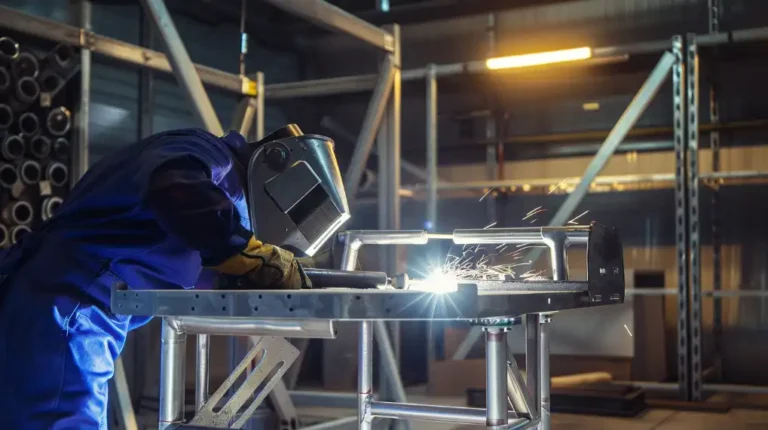
Herausforderungen bei der Schweißmontage
Die schweißtechnische Montage hat zwar viele Vorteile, bringt aber auch einige Herausforderungen mit sich. Diese Herausforderungen müssen angegangen werden, um starke, zuverlässige Schweißnähte zu gewährleisten. Hier sind einige häufige Probleme, die bei der Schweißmontage auftreten:
Hohe Qualifikationsanforderungen für Schweißer
Schweißen erfordert ein hohes Maß an Geschick und Fachwissen. Verschiedene Materialien und Techniken erfordern spezielle Kenntnisse. Unerfahrene Schweißer können schwache Schweißnähte erzeugen, die zu Fehlern im Endprodukt führen. Eine ordnungsgemäße Ausbildung und Zertifizierung sind notwendig, um sicherzustellen, dass die Schweißer ihre Arbeit genau und sicher ausführen.
Konsistente Qualität aufrechterhalten
Manuelles Schweißen ist eine besondere Herausforderung, wenn es darum geht, die Qualität über einen Produktionslauf hinweg einheitlich zu halten. Automatisierte Systeme können helfen, einheitlichere Ergebnisse zu erzielen, aber auch diese Systeme müssen ordnungsgemäß gewartet und kalibriert werden.
Wärmemanagement und -kontrolle
Zu viel Hitze kann zu Verformungen, Durchbrennen oder einer Beeinträchtigung der Materialeigenschaften führen. Andererseits kann eine zu geringe Wärmezufuhr zu schwachen oder unvollständigen Schweißnähten führen. Die Schweißer müssen ihre Technik sorgfältig anpassen, um eine Über- oder Unterhitzung des Materials zu vermeiden.
Handhabung von Materialschwankungen
Die beim Schweißen verwendeten Materialien weisen häufig Unterschiede in der Zusammensetzung, Dicke und Oberflächenbeschaffenheit auf. Diese Unterschiede können sich auf den Schweißprozess und die Qualität des Endprodukts auswirken. Schweißer müssen in der Lage sein, diese Unterschiede zu erkennen und ihre Techniken anzupassen, um eine feste Verbindung zu gewährleisten.
Schlussfolgerung
Die schweißtechnische Montage ist ein wesentlicher Prozess in der Fertigung. Es bietet starke, dauerhafte und effiziente Methoden zum Verbinden von Materialien. Sie können hochwertige und zuverlässige Schweißnähte herstellen, indem Sie die richtigen Schweißtechniken auswählen, Materialien und Verbindungen richtig vorbereiten und bewährte Verfahren befolgen.
Sind Sie bereit, Ihren Schweißprozess zu verbessern? Kontaktieren Sie uns um zu erfahren, wie wir Ihnen helfen können, Ihre Schweißmontagetechniken zu optimieren, um bessere Ergebnisse und kürzere Produktionszeiten zu erzielen.
FAQ
Welches ist das beste Schweißverfahren für mein Projekt und wie wähle ich es aus?
Die richtige Schweißtechnik hängt von Faktoren wie der Materialart, der Projektgröße und dem erforderlichen Präzisionsgrad ab. MIG ist schnell und eignet sich gut für große Projekte, während WIG eine hohe Genauigkeit für dünnere Materialien bietet.
Kann Schweißen automatisiert werden?
Ja, das Schweißen kann mit Robotersystemen automatisiert werden. Diese Systeme sind ideal für die Großserienproduktion und können gleichbleibende, hochwertige Schweißnähte liefern.
Wie kann das Schweißen zur Schaffung einer nachhaltigen Fertigungsindustrie beitragen?
Schweißen ist ein nachhaltiges Verfahren, weil es Materialabfälle reduziert und die Reparatur und Wiederverwendung von Metallprodukten ermöglicht. Moderne Schweißtechniken verringern auch die Emissionen und verbessern die Energieeffizienz.
Weitere Ressourcen:
Automatisiertes Schweißen – Quelle: Keyence
Nachhaltige Produktion – Quelle: Glossar
Schweißtechniken – Quelle: Wcwelding
Hey, ich bin Kevin Lee

In den letzten 10 Jahren bin ich in verschiedene Formen der Blechbearbeitung eingetaucht und teile hier coole Erkenntnisse aus meinen Erfahrungen in verschiedenen Werkstätten.
Kontakt aufnehmen

Kevin Lee
Ich verfüge über mehr als zehn Jahre Berufserfahrung in der Blechverarbeitung und bin auf Laserschneiden, Biegen, Schweißen und Oberflächenbehandlungstechniken spezialisiert. Als Technischer Direktor bei Shengen bin ich bestrebt, komplexe Fertigungsherausforderungen zu lösen und Innovation und Qualität in jedem Projekt voranzutreiben.


